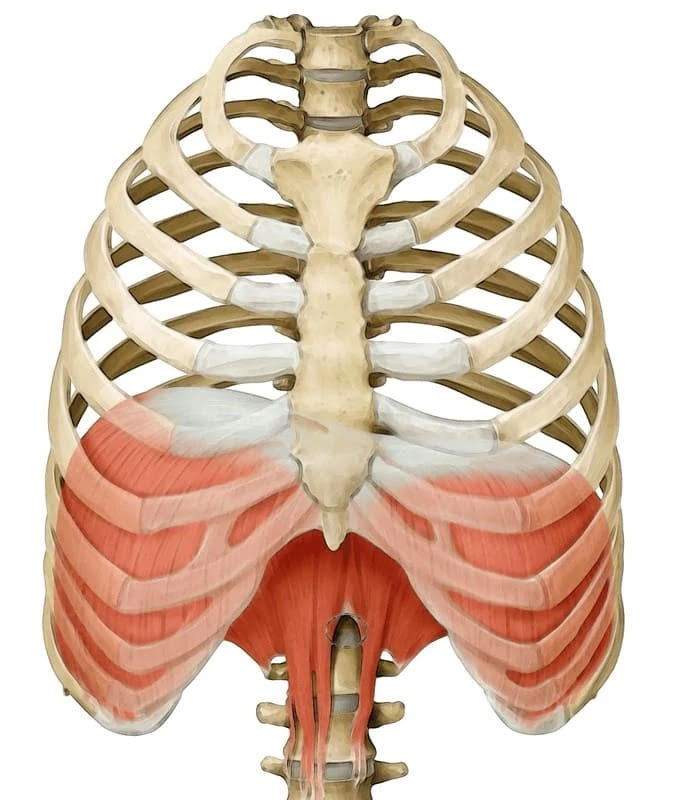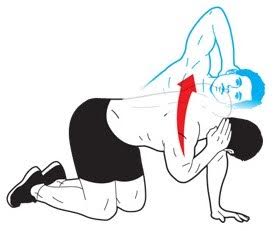Rotation for Overhead Athletes: Thoracic Spine
Aug 23, 2016The thoracic rotation mobility drill is great to perform as part of a warmup. Beginning in position A, take a deep breath and open up the shoulders, lowering the top shoulder down towards the floor to reach position B. On exhalation, try to sink further into the stretch. Stay there for about 5 seconds then back to A. Move through this with your breath 10 times in each direction.Since “retiring” from volleyball, my fitness regimen now consists of weightlifting, rowing, body weight movements, running (let’s call it casual jogging), and so on. What are all of these movements missing? Rotation! I have become very strong in the sagittal plane—cleans, jerks, rowing, squatting, pull-ups. No wonder when I play a pick-up game, I am sore as all get out!
This one goes out to those athletes who continue to be competitive in overhead rotational sports. Tennis players, softball-baseball-volleyballers, I’m looking at you! You guys hang out in the transverse plane a lot so this is where you need strength and control. This is why shoulder and spinal rotation is so vital for power and longevity in your sport and how to begin to maximize your performance.
The Anatomy of Rotation
Rotation in the thoracic spine is normally about 35 degrees but can be difficult to differentiate from lumbar rotation. However, the bony structure of the lumbar vertebra allow much less rotation than thoracic vertebra so we will focus there.
The two major anterior rotators are the external and internal obliques. The external oblique (EO) attaches to the last 6-7 ribs, to the upper fibers of the serratus anterior and lateral fibers of the latissimus dorsi (on the right in picture). Due to these connections, you see how rotation strength would also affect shoulder stability. It acts to cause contralateral rotation; so the left EO turns your trunk to the right. The internal oblique (IO) acts to rotate the torso ipsilaterally, or to the same side (on the left in picture).

Another muscle group that we cannot forget about is the multifidi. These small muscles live on the posterior vertebra and have short connections at each level. Rather than acting as a strength muscle that creates movement, they are stability muscles that control rotation. So as my torso rotates left, my right side fires more than my left to control the amount of rotation allowed.

Training these muscles for strength and motor control are important to maximize power through rotation and decrease the rotational load on the lumbar spine. Rotation at your hips, trunk and then arm are the secret to a powerful throw/swing and minimize damage at these joints. If your thoracic spine is not mobile, the hips and shoulders will take the brunt of the force. This often results in early rotator cuff damage and impingement as well as issues up and down the kinetic chain in the elbow, back, hips and knees.
Spinal mobility and strength is the foundation of overhead sports.
Check your thoracic mobility: kneel on the floor, hands and knees. Put one arm behind your head and then rotate your shoulder and torso on that side up toward the ceiling. How far do you get? For an overhead athlete, it would be ideal that you elbow and shoulder could be straight up. Be sure not to just crank your elbow back, its more about the thoracic spine and shoulder position!

“Wow, people can really rotate in this position?”--if that’s you, then it’s time to begin some thoracic mobility work! Check these out:
Better Upper Back mobility: This one is great for those who sit the majority of the day or who tend to have poor posture (that should have covered 98% of us!) All you need is a double lacrosse ball or Yoga Tune Up balls like those that Danny has in the video.
The thoracic rotation mobility drill is great to perform as part of a warmup. Beginning in position A, take a deep breath and open up the shoulders, lowering the top shoulder down towards the floor to reach position B. On exhalation, try to sink further into the stretch. Stay there for about 5 seconds then back to A. Move through this with your breath 10 times in each direction.“That was easy!”—if you said this then let’s focus on your strength and control. Try these versions a Pallof Press. This exercise as described in the video is great for anti-rotation. The picture depicts another form that works on anti-extension. Just be sure that when you move your arms overhead, your ribs remain stacked above your pelvis. We want to avoid overextension of the back and the ribs poking forward. What I mean by “anti-“ exercises is that you are resisting the band tension that is trying to pull you into rotation and extension, thus working the muscles we highlighted earlier.
“That was easy!”—if you said this then let’s focus on your strength and control. Try these versions a Pallof Press. This exercise as described in the video is great for anti-rotation. The picture depicts another form that works on anti-extension. Just be sure that when you move your arms overhead, your ribs remain stacked above your pelvis. We want to avoid overextension of the back and the ribs poking forward. What I mean by “anti-“ exercises is that you are resisting the band tension that is trying to pull you into rotation and extension, thus working the muscles we highlighted earlier.
As I mentioned before, thoracic mobility and torso strength are just the beginning to a successful and long career as an overhead athlete. Hip complex rotation and shoulder rotation will be highlighted in later posts! But for now, it all starts here!
All of this overhead sport talk has me missing volleyball. So for that, here’s a #ThrowbackThursday.

Thanks for reading!
Dr. Jackie, PT, DPT
Let us help you figure out to live your best active life today!
Remember, Movement is Medicine!

